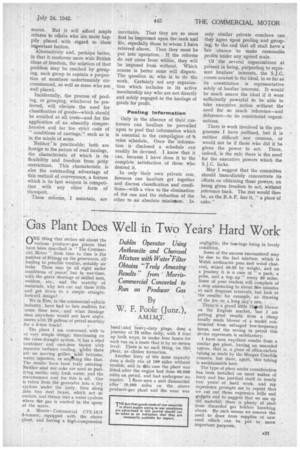Gas Plant Does Well in Two Years' Hard Work
Page 25

If you've noticed an error in this article please click here to report it so we can fix it.
Dublin Operator Using Anthracite and Charcoal Mixture with Water.Filter Obtains "Truly Amazing Results?' from MorrisCommercial Converted to Run on Producer Gas
By W. F. Poole (junr.),
A.M.I.M,T. ONE thing that strikes me about the various producer-gas plants that have been described in "The Commercial. Motor" from tie to time is the number of fitting s on the generators, leading to possible trouble, notably air leaks. These may be all right Under conditions of peace but in war-time, ivith.the grave shortage of skilled men, welders, etc., and the scarcity of materials, why not cut out these frills and get down to a simple straightforward design?
We in Eire, in the commercial-vehicle industry, have had to face realities for some time now, and what haulage man anywhere would not have night mares with 25 gallons of petrol monthly for a 5-ton truck?
The plant I am concerned. with is of very simple design; functioning on the cross-draught system, it has a steel container and cast-iron tuyere with separate radiator cooling, ixhilst there are no moving grilles, false bottoms, water injection, or anything like that. The results have been truly amazing. Neither sisal nor coke are used as purifying media; only fresh water, and the maintenance cost for this is nil. Gas is taken from the generator into a dry cyclone under the body, then along into two dust boxes, which act as coolers, and thence into a water cyclone where the gas is washed in the spray of the water.
A MorrisCommercial CVS.13 /5 5-tonner, equipped with the above , plant, and having a high-compression head \ and heavy-duty plugs, does a journey of 75 miles daily, with 5 tons up both ways, in under four hours for each run on a route that is by no means level: There is no such thing, on this plant, as clinker formation. .
Another lorry' of the same capacity does a daily run of 18& miles without trouble, and in is case the plant was fitted after the engine had done 65,000 miles on petrol, and had undergone no repairs. I have seen a unit dismantled after 10,000 miles on the above producer-gas plant and the wear was negligible, the bearings being in lovely condition.
Some of the success encountered may be due to the fuel mixture, which is Welsh anthracite peas and wood charcoal, mixed 50-50 by weight, and on a journey it is a case of " a pack, a poke, and a top up " every 50 miles. Some of your readers will complain of a stop amounting to about five minutes at such frequent intervals, but look at the results: for example, no drawing of the fire on a long day's run.
There -is a grand little 1241olt blower on the English market, but I am getting good results from a cheap locally made blower of a model constructedfrom salvaged low-frequency horns, and the saving in petrol this device represents is satisfactory.
I have seen excellent results from a similar gas plant, having an uncooled tuyere, that is, a piece of silica-carbon tubing as made by the Morgan Crucible concern, but there, again, this tubing is unobtainable here.
The type of plant under consideration has been installed on most makes of lorry and has justified itself in nearly two years' of hard work, and my experience prompts me to repeat that we cut out those expensive frills and gaglgets and to suggest that we use up old material; there is plenty of steel from discarded gas holders knocking about. -By such means we remove the need to draw from supplies of new steel which can be put to more important purposes.




















































